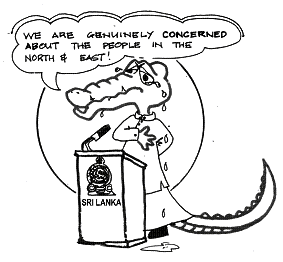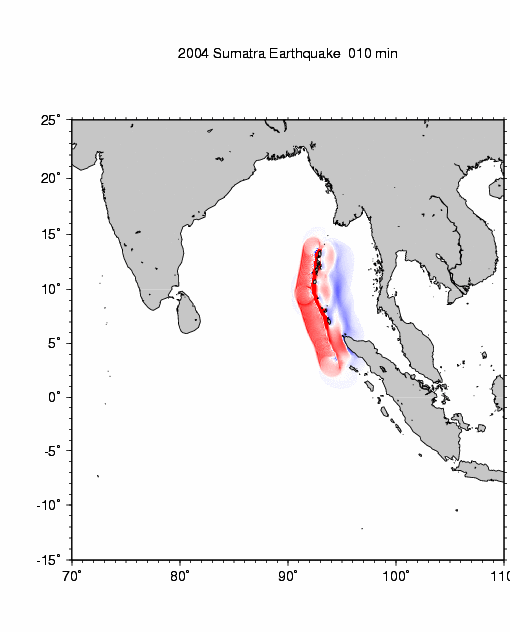Ilankai Tamil Sangam
Association of Tamils of Sri Lanka in the USA
Published by Sangam.org
Tamils Left Out of Sri Lanka's Tsunami Rehab Plans
by IANS, December 26, 2007
|
Rebuilding has been 100 per cent in the south, especially Humbantota district, which is the home of President Mahinda Rajapaksa.
In fact, in Humbantota, nearly 3,200 excess houses were built, and these are now occupied by those not affected by the tsunami.
"The northern province still requires completion of more than 9,000 houses and the eastern province more than 12,000 houses," Jeevan Thiagarajah of the Confederation of Humanitarian Agencies told IANS.
"Not even 12 per cent of fully damaged houses in the north have been rebuilt, and only 26 percent in the east," says NGO Action Aid in its report titled 'Voice from the Field'. This is so even though 60 per cent of the damage wrought by the tsunami was in the east, especially Amparai district in the southeast. |
 Colombo: Sri Lanka's recovery from the devastating tsunami of December 2004 has been uneven. Rehabilitation work has notched up significant successes in the Sinhalese-dominated and more peaceful south, but it has suffered greatly in the war-torn northeast, which has a preponderance of the minority Tamils and Muslims.
Colombo: Sri Lanka's recovery from the devastating tsunami of December 2004 has been uneven. Rehabilitation work has notched up significant successes in the Sinhalese-dominated and more peaceful south, but it has suffered greatly in the war-torn northeast, which has a preponderance of the minority Tamils and Muslims.
And it was the northeast, which took the brunt of the killer waves on Boxing Day, which destroyed about 121,000 houses and killed over 30,000 in the island.
Cabinet spokesperson Anura Priyadharshana Yapa said that 99,497 permanent houses had been built and that work on 19,791 units was in progress. Rebuilding has been 100 per cent in the south, especially Humbantota district, which is the home of President Mahinda Rajapaksa.
In fact, in Humbantota, nearly 3,200 excess houses were built, and these are now occupied by those not affected by the tsunami.
"The northern province still requires completion of more than 9,000 houses and the eastern province more than 12,000 houses," Jeevan Thiagarajah of the Confederation of Humanitarian Agencies told IANS.
"Not even 12 per cent of fully damaged houses in the north have been rebuilt, and only 26 percent in the east," says NGO Action Aid in its report titled 'Voice from the Field'. This is so even though 60 per cent of the damage wrought by the tsunami was in the east, especially Amparai district in the southeast.


Rehabilitation work in the north and east was hampered by the outbreak of hostilities between the Tamil Tiger rebels and government forces in December 2005.
The war has so far claimed 4,500 lives and displaced about 3,00,000 people. It had added another category of displaced, who also had to be housed, looked after and rehabilitated. Scarce government resources had to be diverted from tsunami-related rehabilitation to the rehabilitation of the war-affected.
Military operations had meant restrictions on physical movement of men and material.
"Access to some construction sites is restricted and transportation of material difficult or impossible," said a two-year assessment report of the International Federation of the Red Cross. World Vision had to abandon a plan to build 200 houses in Ichchilampattu in Trincomalee district because of military operations.
Government had also put restrictions on the movement of strategic goods like fuel and building material to the areas controlled by the Tamil Tigers, thinking that these would be misappropriated by the rebels. This affected rebuilding greatly.
The ILO reported that in the south 90 per cent of the affected people had returned to work, but in Jaffna district, isolated from the rest of the island, only 55 per cent had. The rest were relying on income from other sources.
As regards the restoration of livelihood, the all-island figures are impressive. About 2,00,000 persons had lost their jobs due to the tsunami. But according to Thiagarajah, 95 per cent of the men, and 84 per cent of the women, have started earning again. The Federation of Chambers of Commerce and Industry had given 1,96,913 grants, and assisted 8,447 micro, small and medium enterprises between 2005 and 2006.
Again, while this is impressive, the schemes have been operative only or mainly in the south, and to some extent in the southeast. The north has been more of less ignored, thanks to the war, which threatens to continue through 2008.
Money has never been a problem. Sri Lanka has received $1.7 billion of the $3.1 billion pledged by the international community for post-tsunami work. More money can be got if the Sri Lankan government is serious about the development of the tsunami-affected areas. But, as in other cases of foreign assistance, the government has tended to drag its feet on submitting suitable proposals. In fact, indications are that post-tsunami work is winding up.
© 1996-2024 Ilankai Tamil Sangam, USA, Inc.
 Colombo: Sri Lanka's recovery from the devastating tsunami of December 2004 has been uneven. Rehabilitation work has notched up significant successes in the Sinhalese-dominated and more peaceful south, but it has suffered greatly in the war-torn northeast, which has a preponderance of the minority Tamils and Muslims.
Colombo: Sri Lanka's recovery from the devastating tsunami of December 2004 has been uneven. Rehabilitation work has notched up significant successes in the Sinhalese-dominated and more peaceful south, but it has suffered greatly in the war-torn northeast, which has a preponderance of the minority Tamils and Muslims. 
